"Russians are coming!"
January 31 capitulated the southern group led by Field Marshal Friedrich von Paulus. February 2 surrendered the northern German group under Colonel-General Karl Streker. The battle of Stalingrad ended with a decisive victory for the Red Army.
The first stage of the operation
The troops of the Don Front under the command of Lieutenant General K. K. Rokossovsky on the night of January 10 focused on the initial positions. The main attack was delivered by the troops of the 65 Army of P.I. Batov. Her divisions were to attack the direction of the main attack, cutting off the so-called. "Marinov ledge", in cooperation with the troops of the adjacent flanks of the 21 th and 24 th armies. Towards the shock grouping of the 65 Army from the area south of Tsybenko, a strike was made in the general direction of the patrols of Basargino, Novy Rogachik and the troops of the adjacent flanks of the 64 and 57 armies. From the region south-west of Erzovka on the Settlement, the offensive was conducted by the forces of the 66 and 62 armies.
Artillery preparation began at 8 o’clock. 5 minutes. 7 thousand guns and mortars within 55 minutes destroyed the German defense. Soviet artillery destroyed enemy firing positions, destroyed its headquarters, communications, bunkers and dugouts, and destroyed manpower. The commander of the 65th Army, Pavel Ivanovich Batov, first applied the "rampart" method of artillery support - this tactic subsequently became widely used by Soviet troops. Actively acted and aviation 16th Air Army. At 9 o’clock the infantry and Tanks went on the attack. The troops advanced slowly, the Germans fiercely fought back. In the direction of the main attack, by the end of the day, the 65th Army wedged into the enemy’s defenses to a depth of 1,5-4,5 km. The troops of other armies advanced even less.
After only three days of stubborn and bloody battles, the Marinovsky (Western) overhang of the defense of the German 6 was cut off. At the end of the day on January 12, the troops of the 65 and 21 armies reached the west bank of the r. Rossoshki and Karpovka area. In other areas, the Soviet troops also broke the enemy defenses and stubbornly moved forward. On the night of January 11, German defenses were punched in the southern sector of the encirclement, and in the offensive zone of the 57 Army, the 38 Infantry Division under the command of Colonel G. B. Safiulina captured a German airfield near Voroponovo with 18 operational aircraft at dawn. The personnel of the airfield, sleeping in dugouts, were taken aback and taken prisoner. January 13 The soldiers of the 15 Guards Rifle Division attacked enemy positions on the east bank of the r. Scarlet Our soldiers captured the Old Horn, overcame the line on the river. Scarlet and went to the railway at the station. Karpovskaya.
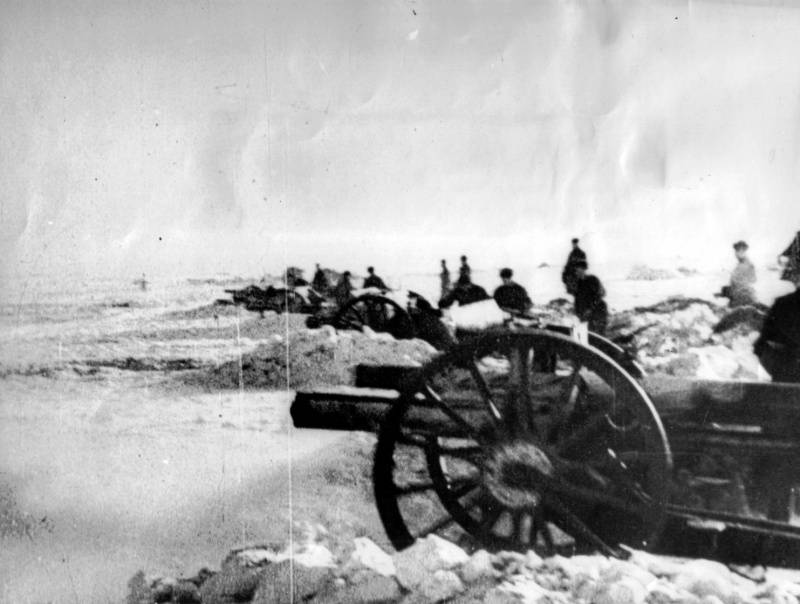
Soviet artillery fires on the encircled German forces in Stalingrad. Presumably, in the foreground an 76-mm regimental cannon model 1927 of the year
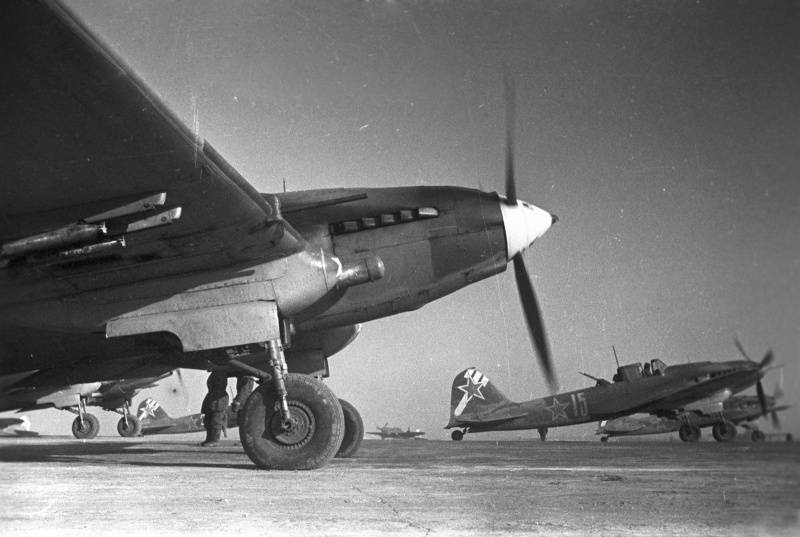
IL-2 attack aircraft take off for a combat mission near Stalingrad
Paulus reported to the headquarters in East Prussia: “about the breakthroughs of large Russian forces in the north, west and south, aimed at Karpovka and the Kennel. 44 and 76 I infantry divisions suffered heavy losses; The 29-I motorized division has only separate combat-ready units. There is no hope of restoring the situation. Left Dmitrievka, Tsybenko and Rakotino ". The answer of the supreme German command was: “By all means keep the line of Tsybenko, Karpovka, Rossoshka. By all means prevent the Nursery from falling into the hands of Russians. Tsybenko, by all means discourage the enemy. Army commander to report on taken countermeasures, as well as under what circumstances Tsybenko was left without the permission of the OKH. ”
However, no orders could restore the combat capability of the army, which was running out of ammunition and fuel, which was starving and frozen. Discipline has fallen disastrously, panic has covered entire German units and units. So, when on January 12 several Soviet tanks appeared near the airfield of the Nursery, the Germans hurriedly fled from there.
A participant in the battle, V. Adam, tells the story of an eyewitness to this episode, a German staff officer: “The panic began suddenly and turned into unimaginable chaos,” he said. “Someone shouted:“ Russians are coming! ”. In the blink of an eye, the healthy, the sick, and the wounded — all jumped out of the tents and dugouts. Everyone tried to get out as soon as possible. Some were panicked in a panic. The wounded clung to their comrades, leaned on sticks or rifles and hobbled like that in the icy wind towards Stalingrad. Exhausted on the way, they immediately fell, and no one paid attention to them. A few hours later they were corpses. Violent struggle ensued because of places on the cars. Ground staff of the airfield, orderlies and light-wounded first rushed to the surviving passenger cars on the edge of the airfield Nursery, started the engines and rushed to the highway leading to the city. Soon, whole clusters of people hung on wings, steps, and even radiators. Machines almost fell apart under such a weight. Some stopped due to lack of fuel or engine malfunction. They overtook without stopping. Those who were still able to move, flee away, the others cried for help. But it did not last long. Frost did his job, and the screams subsided. Only one motto acted: “Save yourself who can!”. But how was it possible to escape in a broken city, in which the Russians continuously attacked us? It was not about salvation, but about self-deception spurred by fear, dangling, half-dead people, physically and morally broken in a battle of annihilation. ” True, it soon became clear that it was only Russian intelligence and the Germans returned to the Kennel.
Soviet troops continued the offensive. Rokossovsky decided to shift the main blow from the area of the 65 Army to the strip of the 21 Army, which was to attack in its direction of the left wing. Voroponovo. 65-I army the troops of the right wing struck in the direction of Novo-Alekseevsky. Its actions from the north were supported by the right flank of the 24 Army, the 57 and 64 armies ensured the advance of the main attack force from the south. By regrouping the troops produced by 13 and 14 in January, the composition of the 21 Army was strengthened. Despite the strong resistance of the Germans at the turn of the river. Rossoshki, Soviet troops, pulling up artillery, with a battle overcame this river and continued to develop the offensive. The enemy, throwing heavy weapons and military equipment, retreated. Panic was observed, the Germans threw the wounded and sick. For Rossoshkoy part of the German troops was surrounded and captured. The troops of the 64 and 57 armies completed the cleansing of the east bank of the Nazis from the Nazis. Scarlet, and then occupied the Karpovskaya railway station, Basargino junction.
The German command tried to keep the airfield in the Nursery in their hands, but all efforts to stabilize the front were in vain. German troops lost strongholds from the Big Rossoshka to Baburkin and Novo-Alekseevsky. 14 January 214-Infantry Division 65-th army moved south to the airfield Nursery. The airfield was captured on the night of January 15. In the morning, a meeting of units of the 65 and 24 armies occurred. Meanwhile, the troops of the 64 and 62 armies were actively engaged in active operations in the northeastern part of the encirclement area and directly in Stalingrad. The forces of Paulus’s army were not allowed to be transferred to the western part of the “boiler” where the main actions took place.
The headquarters of the German army moved from Gumrak even closer to Stalingrad, to the area of the 71 Infantry Division, where dugouts were equipped in a deep beam on a steep slope. "Hartmanstadt" - so the Germans called the new command post of the army, by the name of the division commander von Hartmann (after his death, the division commander became Colonel Rosske). “Documents and military assets were burned again,” V. Adam noted. “Only the most necessary things were taken to the new command post. We drove along the highway in the few surviving cars, in small groups, past the hauled, haunted, sick and wounded soldiers who were haunted and ghostlike. At the station in Gumrak, we fell into a dense crowd of wounded. Driven by fear, they left the infirmary at the airfield and also rushed east. Only the seriously injured and hopelessly ill remained, whose evacuation due to a lack of vehicles was impossible. Hope to cure them still was not. Paulus ordered the chief doctors to leave the infirmary to the advancing enemy. The Russians also found a pile of numbed corpses of German soldiers, who a few weeks ago were piled on this house of death one upon another, like logs. The orderlies did not have the strength to dig a pit for the dead, hardened like steel. There was no ammunition to blow up the earth and bury the dead in it. ”
By the end of January 17, the 64, 57, 21, 65, and 24 armies reached the nearest approaches to Stalingrad along the line of Bolshaya Rossoshka, Gonchara farm, Voroponovo. The length of the front line in the encirclement ring was 110 km, and the depth of its region decreased from west to east by 33 km and was 20 km (to the Krasny Oktyabr settlement). From north to south, it was equal to 30 km. The total area of the neighborhood has decreased by 800 square. km and was about 600 square. km German troops, retreating to the east, occupied the inner defensive line, and continued to show desperate resistance. The command of the 6 Army tried to keep the fighting spirit of the soldiers and officers by intimidating them. One of the orders said: “We all know what threatens us if the army ceases to resist; most of us are waiting for certain death, either from an enemy bullet, or from hunger and suffering in the shameful Siberian captivity. But one thing is certain: he who surrenders as a prisoner will never see his loved ones again. We have only one way out: to fight to the last bullet, despite the increasing cold and hunger. Therefore, all attempts to negotiate should be rejected, left unanswered and parliamentarians banished with fire. ”
However, the fighting efficiency of the German troops fell uncontrollably. On January 20, Paulus reported to the command of the army group and the high command of the ground forces: “The combat efficiency of the troops is rapidly declining due to the catastrophic situation with food, fuel and ammunition. There are 16 thousand wounded who do not receive any care. ... The phenomena of moral decay are beginning to be noted. Once again, I ask for freedom of action in order to continue resistance, as long as possible, or to stop hostilities if they cannot be waged, and thereby provide care for the wounded and avoid complete decay. " The High Command refused: “Surrender is ruled out. Army carry out its historical the task is to, with their strong resistance, to the last opportunity, facilitate the creation of a new front in Rostov and north and the withdrawal of the Caucasian army group. " As a result, the command of the 6th Army continued to resist. At the Orlovka-Gumrak-Peschanka line, hiding behind the fortifications of the former internal contour, the enemy concentrated all the remaining reserves.
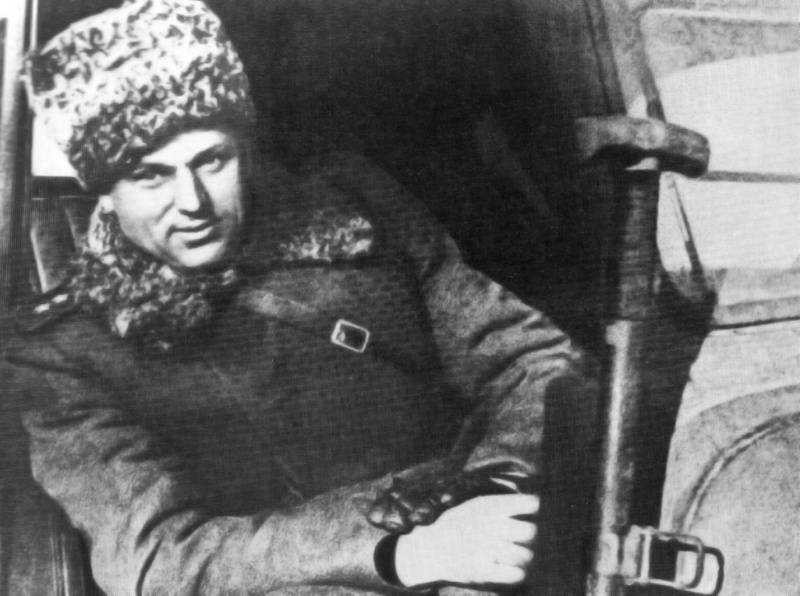
Commander of the Don Front, Army General Konstantin Rokossovsky in Stalingrad after victory
The last assault on Stalingrad
18 - January 19 made a regrouping of the Soviet troops. But even these days stubborn battles continued on the left flank of the 21 Army, as well as in the offensive zone of the 65 and 24 armies. The Soviet command decided to complete the liquidation of the enemy grouping with a general assault on the entire front. The main blow inflicted 21-I army in Gumrak, pos. Red October, splitting the enemy grouping into two parts. The troops of the legal flank, the 65 Army, interacting with the 21 Army, struck in the direction of Aleksandrovka, northern outskirts of the village. Red October, 24-I army also came from the west. In the north-eastern part of the encirclement area, as before, the 62 and 66 armies were to attack.
22 January 1943, the troops of the Don Front went to storm the enemy positions. A powerful artillery strike struck the German positions. The intensity of the strikes can be judged from the fact that 22 guns and mortars were concentrated in the 64-kilometer zone of the 57, 21 and 4100 armies. For four days of fighting, Soviet troops advanced on 10 - 15 km. The left-flank connections of the 21 Army took an important stronghold of the enemy - Gumrak, cutting the railway here. The troops of the 65 Army of January 25 occupied the strong points of Aleksandrovka, the Settlement. The 64-I and 57-I armies, advancing from the south of Stalingrad, broke through the German defenses in the internal contour and defeated the enemy’s garrisons in Kuporosny, Yelshanka, Peschanka, on Art. Voroponovo, in with. Alekseevka, at st. Sadovaya, moved to the east and northeast.
As a result, in 16 days (10 - 25 in January 1943), the German group lost up to 100 thousands of people killed, wounded and prisoners. The territory occupied by the enemy, was reduced to 100 square. km Its length from north to south was 20 km, and from west to east - only 3,5 km. The troops of the Don Front went to the south-western and western outskirts of Stalingrad, fighting went on the streets of the city.

German automobiles captured by Soviet troops. From left to right - a standardized Henschel 33 truck, a MAN bus, a 3-ton Ford G 977T truck, followed by an earlier Ford G917t, in the foreground a standardized 1,5 ton 3 Mercedes-Benz G1929a truck of the 170 model, then a passenger 82 ton XXUMX truck, followed by an XNUMX Mercedes XNUMX toned truck, then an XNUMX Mercedes-Benz GXNUMXa. Volkswagen type XNUMX
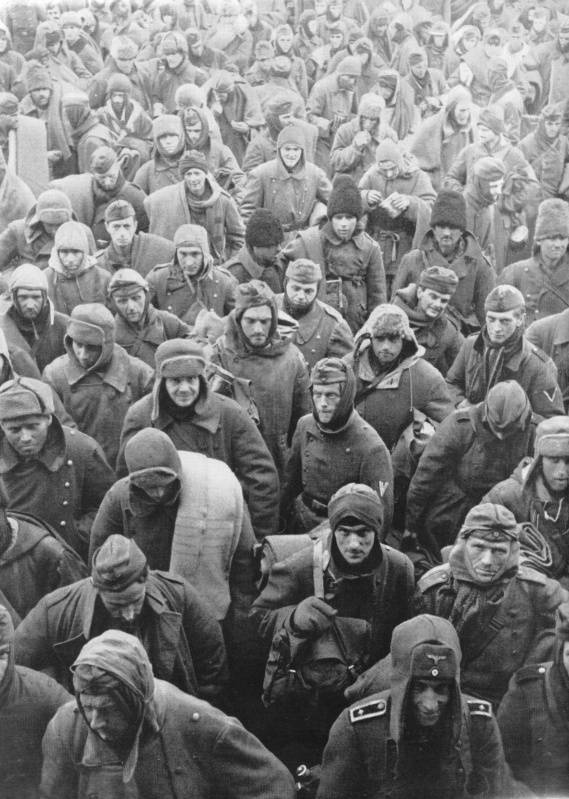
Column of captured Germans, Romanians and Italians at Stalingrad
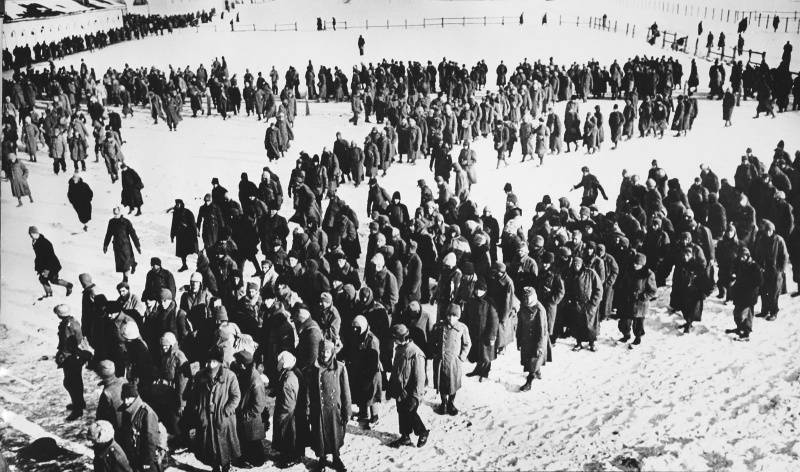
German prisoners in the area of Stalingrad
These days, German writer Erich Weinert, who acted as an anti-fascist propagandist on the front lines of the Soviet-German front, noted in his front-line diary: “The last remnants of the cauldron break up, the 6-I Hitler army concentrated on the edge of Stalingrad and in Gorodishche. Continuous flashes are visible above the steppe, cannonade is heard. Hundreds of guns shoot so that you can deaf. The closer we come to Stalingrad, the worse the picture. On the side of the road sit and lie those who could not leave - abandoned, broken, frostbitten. One leaned against the pillar of the road sign and hugs him. On the post there is an inscription: "Nach Stalingrad". In the ravine leading to the Gonchar farm, yesterday was probably hell. The entire ravine is littered with damaged and burnt tanks and vehicles. Some turned upside down. Plugged tower hoods and torn guns block the road. And at every step the corpses and parts of human bodies. ... Behind us, in the ravine, thunder guns, induced by the last fortifications of Stalingrad. The terrible "Katyushas" make noise so that the earth shakes. "
On January 24, Paulus again asked Stavka for the right to surrender: “I report on the situation on the basis of reports from the corps and a personal report of those commanders with whom I could contact: the troops do not have ammunition and food; communication is maintained only with units of six divisions. On the southern, northern and western fronts, phenomena of decomposition of discipline are noted. Uniform control of troops is impossible ... 18 000 is not wounded even the most elementary help due to the lack of dressing facilities and medicines. 44, 76, 100, 305 and 384-I infantry divisions destroyed. Due to the penetration of the enemy in many areas of the front is broken. Strong points and shelters are only in the area of the city, further defense is meaningless. Disaster is inevitable. To save the survivors, I ask for immediate permission for surrender. ” January 25: Hitler replied: “I forbid capitulation! The army must hold its position to the last man and to the last bullet! ”
On the morning of January 26, the troops of the 21 and 65 armies struck a powerful blow at the enemy. The troops of the 62 Army made their way to meet them. By the end of January 26, units of the 21 Army were united in the area of the Krasny Oktyabr settlement and on Mamayev Kurgan with the units of the 62 Army advancing from Stalingrad. The enemy in the city was split into two parts - the southern group in the central part of the city and the northern group in the area of the Tractor and Barricades factories. In the southern part of the city, surrounded by the 64, 57 and 21 armies, were the remains of six infantry, two motorized and one cavalry divisions of the German army. The troops of the 62, 65 and 66 armies in the northern part of the city surrounded the remnants of three armored, one motorized and eight infantry divisions. Paulus appointed the commander of the 11 Army Corps General of the Infantry, Karl Strecker, commander of the northern group of troops, and Commander of the 71 Infantry Division, Major General Rosske as commander of the southern group of troops. In fact, the leadership of the southern group was carried out by the headquarters of the 6 Army and Paulus himself, located in the location of this group.
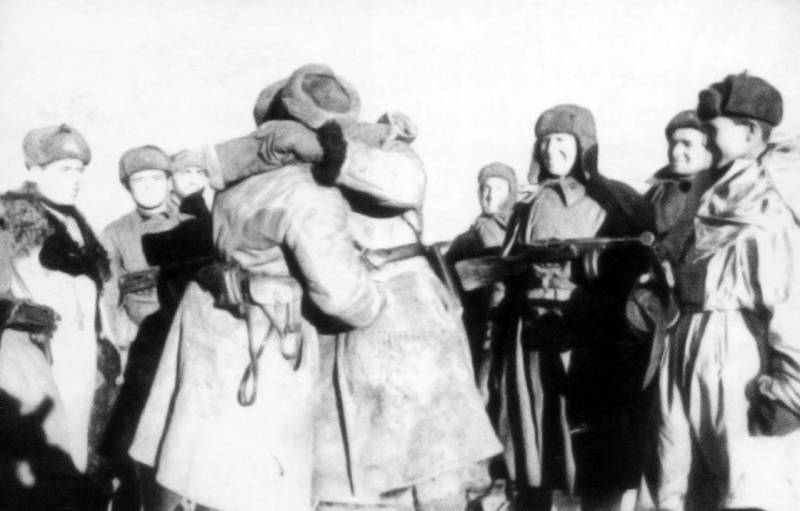
Meeting of 21 and 62 Army fighters on the north-western slopes of Mamayev Kurgan. 26 January 1943
Capitulation of the remnants of the German troops
Since January 27, Soviet troops have been fighting to eliminate the dismembered German group. The Germans, having lost the will to resist, surrendered in large groups in captivity. However, in places the fierce fighting continued. Thus, in the southern sector, a particularly stubborn struggle was going on for the elevator, the bakery, the Stalingrad-II station, the Dargorsk church and the buildings adjacent to them. Troops of the 64, 57 and 21 armies from the southwest and northwest squeezed the encirclement around the enemy's southern grouping. On the night of 28 on 29 in January, the left-flank connections of the 64 Army, overcoming the r. Queen, went to the central part of the city. The southern group of the enemy was divided into two parts. Folded weapon and whole divisions and units surrendered. 30 January in the center of the city were still stubborn fighting. The troops of the left flank of the 64 Army - the 29-I Rifle Division, 38-I Motorized Rifle Brigade and 36-I Guards Rifle Division - fought for the central part of the city, 7-Rifle Corps and 204-I Rifle Division of the army of Shumilov destroyed the enemy north of the mouth of the river. Queen, along the banks of the Volga. The troops of the 21 Army were advancing from the northwest.
The 38-I motorized rifle brigade of Colonel I. D. Burmakova, advancing on the Fallen Fighters Square, met with particularly stubborn resistance from two buildings on Lomonosov Street. From the prisoners we learned that these buildings are strongholds on the approaches to the Central Department Store, in the basement of which the headquarters of the German 6 is located. The Soviet soldiers cleared the buildings from the enemy, where previously the regional party committee and the regional executive committee, as well as the houses adjacent to them, were located. Then they stormed off the remains of the buildings of the city theater and the House of Soviets, located on the Square of Fallen Fighters. Soon the area was completely cleared from the Nazis. As a result, the 38-i motorized rifle brigade, in cooperation with the 329-m engineering battalion at night from 30 on January 31, blocked the building of the department store.
By Paulus, who was in one of the rooms of the basement of the store, entered the chief of staff, General Schmidt. He gave the commander a sheet of paper with the words: "I congratulate you on the production in field marshal generals." This was the last radiogram received in the "boiler" from the Führer.
Aware of the futility of further resistance, the command of the 6 Army decided to capitulate. From the basement of the department store, following an order from Schmidt, a translator came out with a white flag and, approaching a Soviet tank standing nearby, told his commander that the German command was ready to negotiate with the Soviet command. The tankman on the radio immediately contacted his commander. The chief of staff of 6 of the German army, Lieutenant-General Schmidt, and the commander of the southern group of encircled troops, Major-General Rosske, in 8 hours on January 31 informed the representatives of the 64-th army that they were ready to begin negotiations on surrender. General Shumilov appointed the delegation headed by the Chief of Staff of the Army Major General I. A. Laskin to conduct negotiations. Soon the headquarters of the 64 Army headquarters, Colonel G. S. Lukin, the head of the army’s intelligence department, Major I. M. Ryzhov, and the deputy head of the army headquarters for political affairs, Lieutenant Colonel B. I. Mutovin arrived at the German headquarters. The delegation presented an ultimatum to Generals Schmidt and Rossk about the immediate cessation of resistance and the complete surrender of the southern group of troops. Terms of surrender were accepted. Almost at all sites the Germans began to surrender in masses by the masses. It was about 9 in the morning.
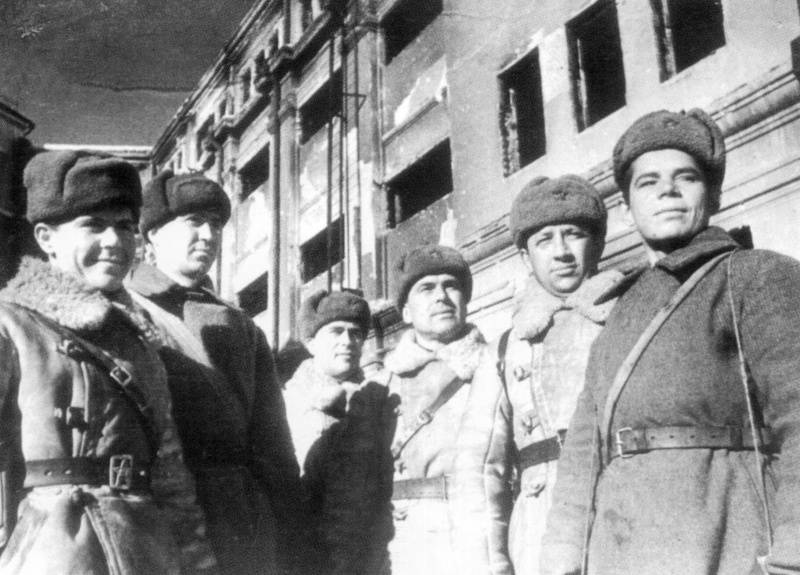
Soldiers and commanders of the 38 th motorized rifle brigade M. S. Shumilova, who captured the headquarters of the 6 th German army surrounded in Stalingrad. Third from right: brigade commander Col. I. D. Burmakov
After some time, Major General Laskin, Chief of Staff of the 64 Army, arrived in the basement of the department store. He again announced the terms of the surrender and invited the commander of the southern group, Major General Rosske, to sign an order on the cessation of hostilities and the surrender of weapons. These requirements have been met. However, when General Laskin suggested that Paulus give an order to surrender to the northern group of forces, he replied that he did not consider himself entitled to give such an order. Field Marshal Paulus, Generals Schmidt, Rosske and other German generals and officers were taken to Beketovka at 12 Army headquarters at 64 and sent to the Don Front headquarters at 19 hours. Thus, on January 31, 1943 of the year ended the liquidation of the southern group of the German 6.
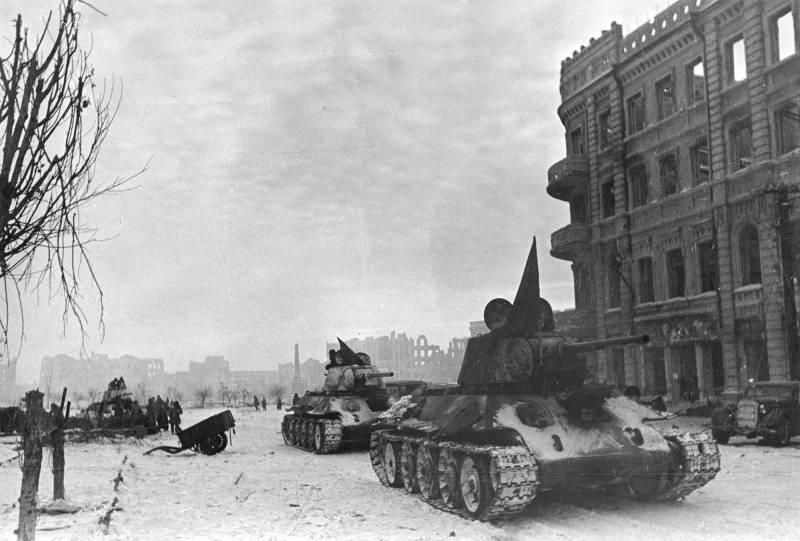
Soviet T-34 / 76 tanks near the Square of Fallen Fighters in Stalingrad passing by the building of the House of the Red Army on Gogol Street
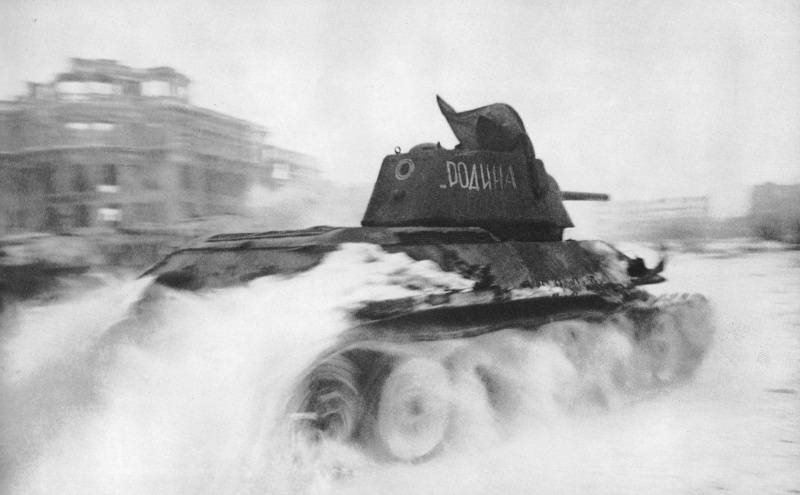
Tank T-34 with the name "Homeland" on the Square of Fallen Fighters in Stalingrad. To the left you can see the famous building of the central department store, badly damaged during the fighting.
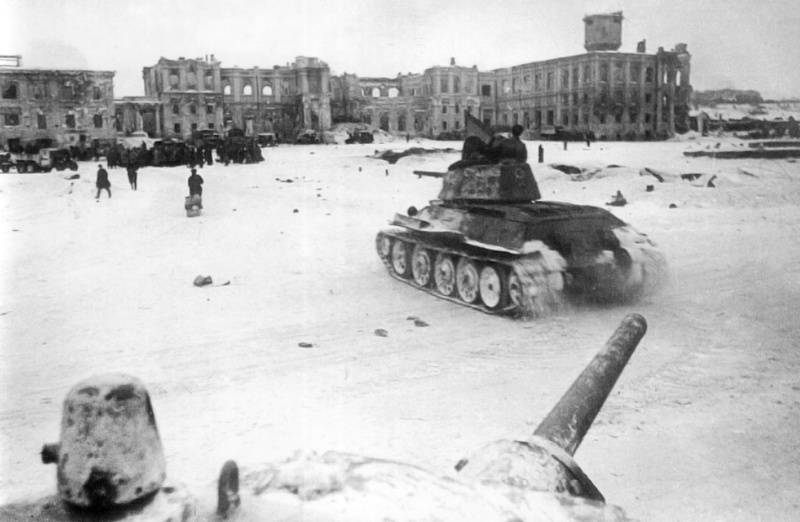
The central square of Stalingrad - the Square of Fallen Fighters of the Revolution (Square of Fallen Fighters) - on the day of the surrender of the German troops in the Battle of Stalingrad. Soviet T-34 tanks are leaving the square. 31 January 1943
The northern group was still fighting back. General Strecker refused to capitulate. February 1 on the enemy was hit by a powerful blow of artillery, which was carefully prepared. Gunners were preparing all night. In some places they put the guns very close. The guns stood in two lines. The second line is in the form of a tier. The commander of the 65 Army, Lieutenant-General P.I.Batov, in his memoirs about this, wrote: “... And now all this power rumbled. After 3-5 minutes from the dugouts, basements, from under the tanks began to pop up, crawling out the Nazis. Some fled, others knelt, distraught, raised their hands to heaven. Some of them rushed back to the shelter and hid out among the pillars of smoke and jumped out again ... ”
Artillery preparation was conducted on the sites of the offensive of all three armies. At the same time, aviation bombarded the enemy. The Germans could not stand the terrible blow and began to surrender. 2 February, the northern group of enemy troops in the factory area of the city capitulated. Over 40, thousands of German soldiers and officers under the command of General Strecker laid down their arms. The fighting on the banks of the Volga ended.
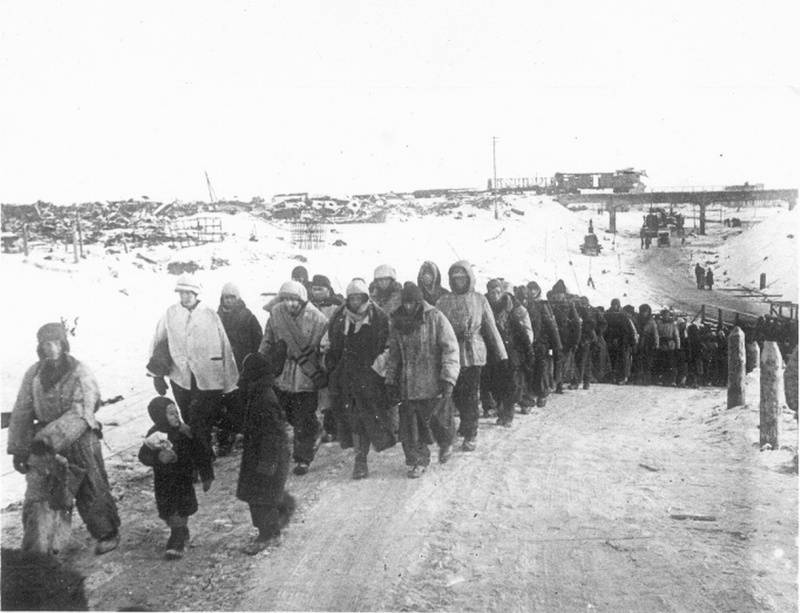
German prisoners from 11 Army Corps General Colonel-General Karl Strecker, who surrendered to February 2 1943. District of the Stalingrad Tractor Plant
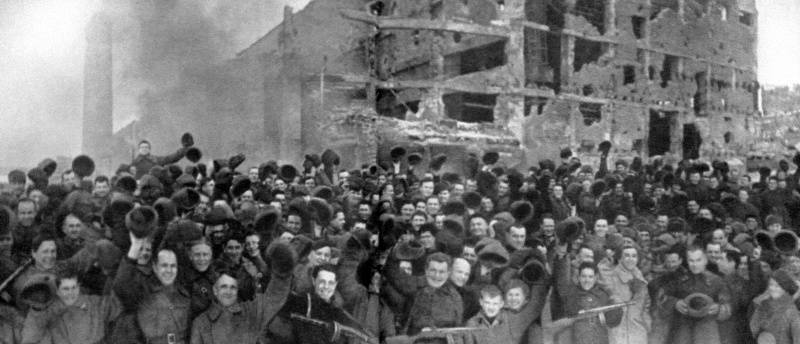
The best fighters of the 95 th rifle division (62-I army) after the liberation of the plant "Barricades" were photographed at the shop, which was still burning. Soldiers rejoice at the thanks received by the Supreme Commander I.V. Stalin parts of the Don Front. In the first row to the right is the division commander, Colonel Vasily Akimovich Gorishny. 2 February 1943. For the valor and bravery of fighters and commanders shown in the battles for Stalingrad, the 95 Rifle Division was given the rank of Guards, and 1 in March 1943 it was transformed into the 75 Guards Rifle Division. Division Commander Col. V.A. Gorishny was awarded the Order of the Red Banner, he was awarded the rank of guard, Major General.
Results
Operation "Ring" ended with the complete victory of the Red Army. The enemy's Stalingrad grouping was dismembered and destroyed. The remnants of the 6 of the German army led by the command capitulated. Stalingrad again became the rear of the ongoing war. The front rolled away from him further.
During the liquidation of the surrounded Stalingrad group from January 10 to February 2, the Don Front under the command of General Rokossovsky defeated the enemy's 1943 divisions, as well as over 22 of the various units of the German 160 reinforcement and service units. 6 Thousands of people, including more than 91 officers and 2500 generals, were captured. In these battles, the Germans lost about 24 thousand people.
Operation “Ring” ended the battle of Stalingrad. A radical change occurs not only in the course of the Great Patriotic War, but also throughout the Second World War as a whole. In the course of its German unit lost a quarter of the forces operating on the Russian front. The German 6-i and 4-i tank armies, the Romanian 3-i, 4-i and Italian 8-I armies were defeated. The total losses of the enemy killed, wounded, captured and missing were about 1,5 million. In Germany, for the first time in the war years, national mourning was declared. The losses of the Red Army amounted to about 1130 thousand people (of which about 480 thousand irrevocable). The strategic initiative firmly and finally passed into the hands of the Soviet military-political leadership, conditions were created for the deployment of the general offensive of the Red Army and the expulsion of the invaders from the occupied regions of the USSR.
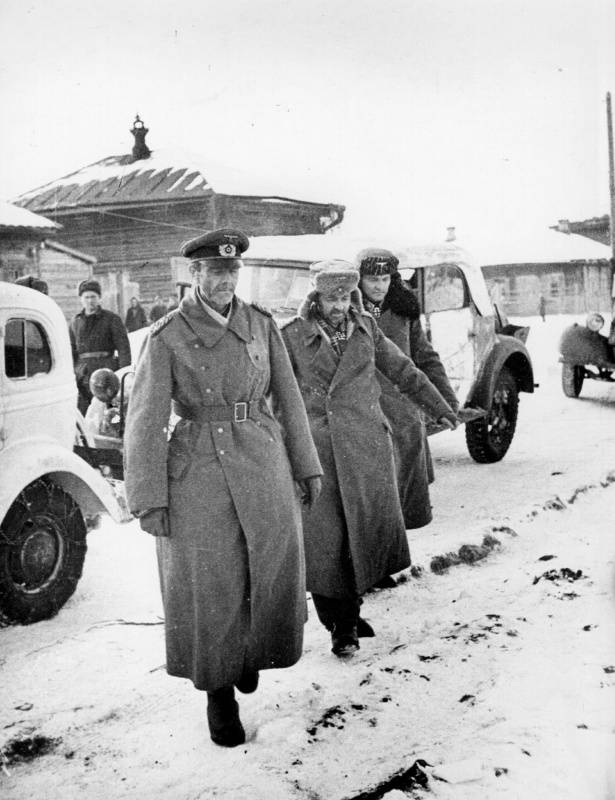
Field Marshal Friedrich Paulus (left), Commander of the Wehrmacht 6 Army surrounded in Stalingrad, Head of its Staff Lieutenant General Arthur Schmidt and his adjutant Wilhelm Adam after being captured. Stalingrad, Beketovka, headquarters of the Soviet 64 Army. 31 January 1943
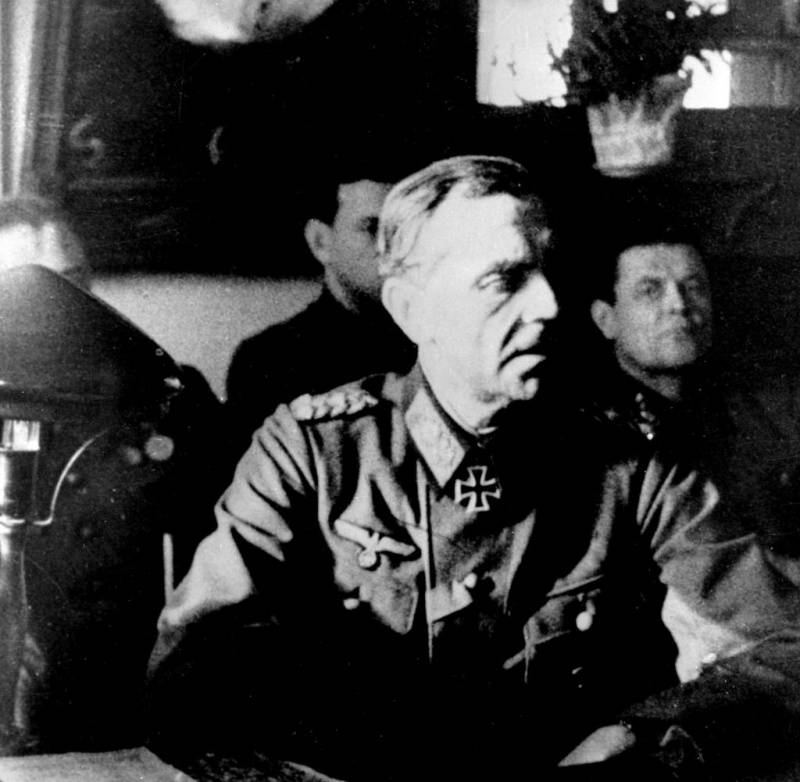
The captured commander of the surrendered German 6 Army Friedrich Paulus under interrogation at the headquarters of General Shumilov's 64 Army in Beketovka
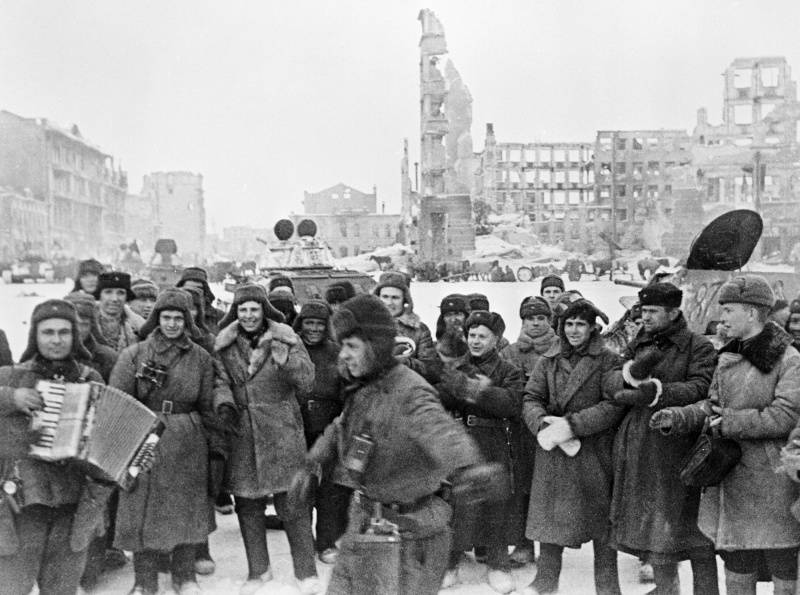
Red Army soldiers with an accordion celebrate victory in the Battle of Stalingrad on the Square of Fallen Fighters in liberated Stalingrad
The victory at Stalingrad raised the international prestige of the Soviet Union and its armed forces, strengthened the anti-Hitler coalition. The United States and England will think about the need for a real opening of a second front in order to maintain their positions in Western Europe. The Anglo-Saxon rate to defeat the Soviet Union and the exhaustion of Germany in the war, which led to the complete victory of the Anglo-American bloc in the world war, was beaten. London and Washington had to step up their actions in Europe
The foreign policy positions of Germany were undermined. Japan did not dare to attack the USSR in the Far East. Turkey, ready to oppose the Union after the German army seized Stalingrad and the Caucasus, remained neutral. The terrible defeat of the Italian army at Stalingrad led to a sharp decline in the authority of Benito Mussolini. The relationship between Rome and Berlin has deteriorated dramatically. Soon in Italy there will be a coup and the Duce will lose control of the country.
The Romanian and Hungarian troops suffered a heavy defeat in the Stalingrad sector, were demoralized and could not fully recover. Now Germany could not count on new conscription troops from Romania, Hungary, and Slovakia. She had to use the remaining divisions of the Allies only for the rear service, the fight against the partisans and on some minor sectors of the front.
German authors, as a rule, biased coverage of events on the Eastern Front, were forced to admit the real defeat of Germany. General Z. Westphal wrote: “The defeat at Stalingrad terrified both the German people and their army. "Never before in the entire history of Germany has there been a case of such a terrible death of so many troops." The German historian V. Gerlitz in the book “History of the Second World War” emphasized: “The catastrophe near Stalingrad was a great turnaround not only in the domestic political sense, but also in the foreign political sense. It resulted in a severe shock to the entire sphere of German rule in Europe. ”
German General Kurt von Tiplskirch in his book “The History of the Second World War” noted: “The result of the attack was tremendous: one German and three allied armies were destroyed, three other German armies suffered heavy losses. At least fifty German and Allied divisions no longer existed. The remaining losses amounted to a total of twenty-five more divisions. A large number of vehicles were lost — tanks, self-propelled guns, light and heavy artillery, and heavy infantry weapons. Losses in technology were, of course, significantly greater than those of the enemy. The losses in the personnel should be considered very heavy, especially since the enemy, even if he suffered serious losses, still had considerably large reserves of people. The prestige of Germany in the eyes of its allies greatly shaken. Since at the same time and in North Africa an irreparable defeat was inflicted, the hope of a common victory collapsed. The morale of the Russians rose high. ”
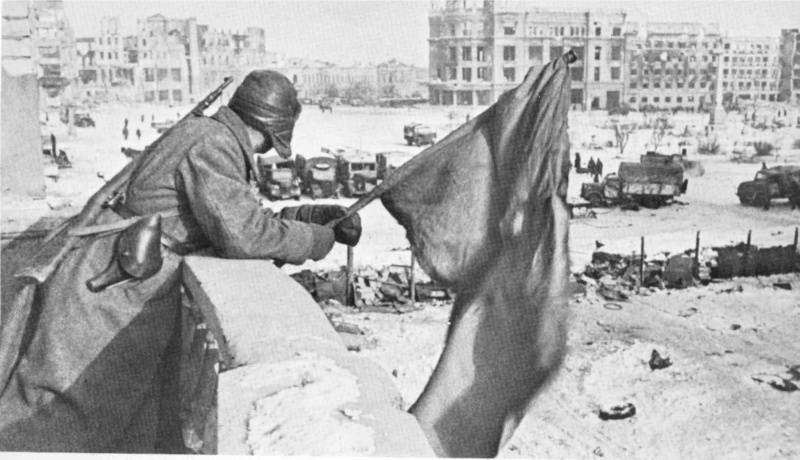
Red flag over the Square of Fallen Fighters liberated Stalingrad. In the background is a department store building where the headquarters of the Wehrmacht's surrounded 6 Army, led by Field Marshal Paulus, was captured. On the square - German trucks captured by Soviet troops.
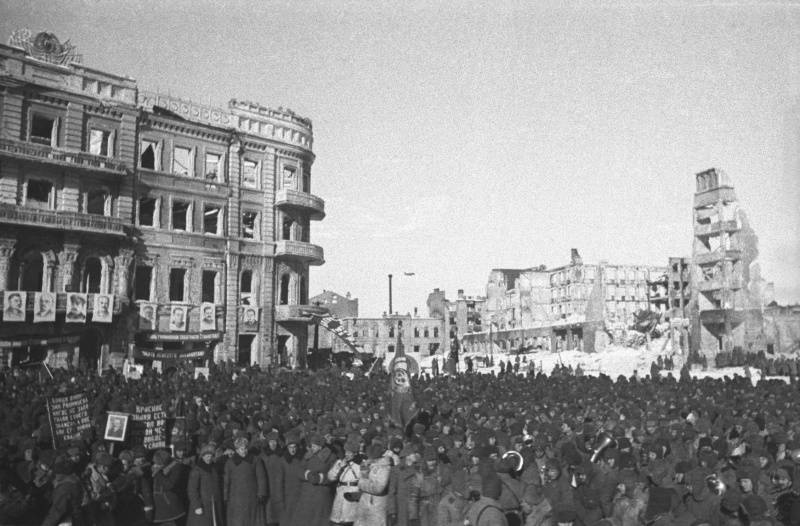
Rally in the liberated Stalingrad. February 1943. Photo source: waralbum.ru
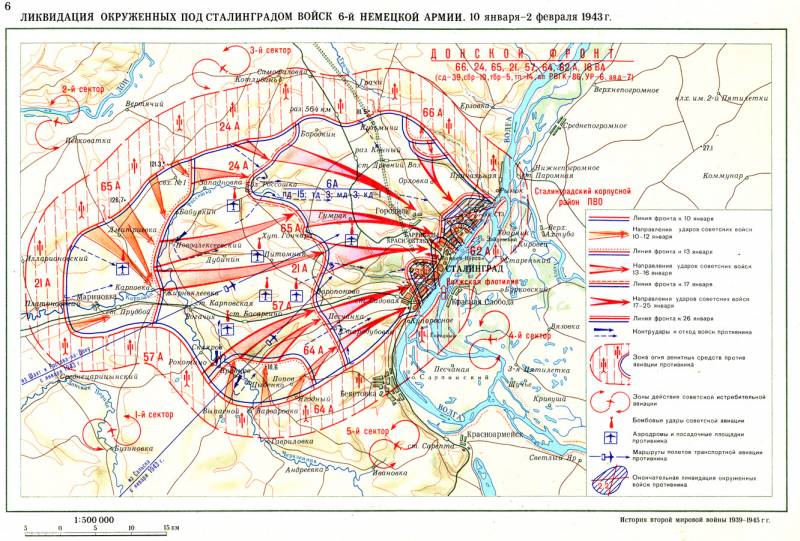
Information